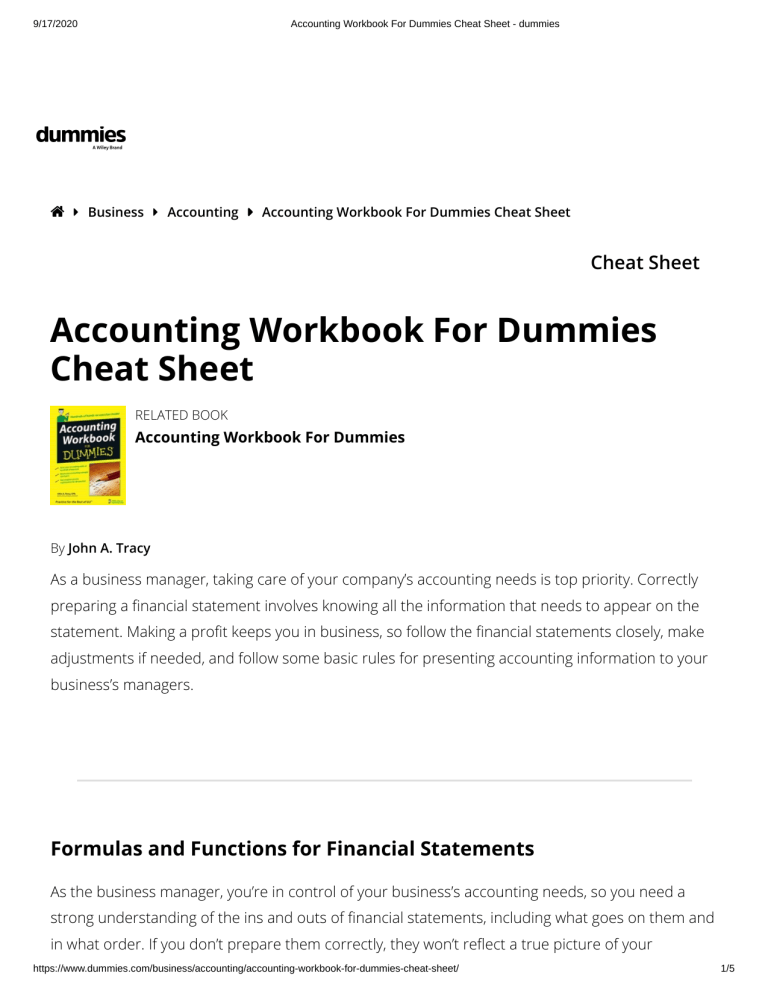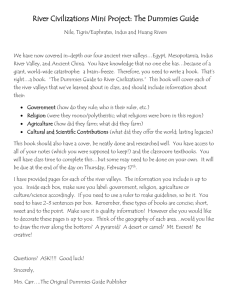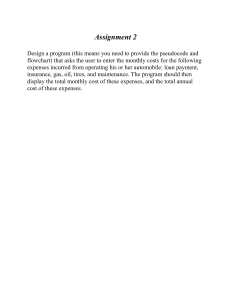
9/17/2020 Accounting Workbook For Dummies Cheat Sheet - dummies Business Accounting Accounting Workbook For Dummies Cheat Sheet Cheat Sheet Accounting Workbook For Dummies Cheat Sheet RELATED BOOK Accounting Workbook For Dummies By John A. Tracy As a business manager, taking care of your company’s accounting needs is top priority. Correctly preparing a nancial statement involves knowing all the information that needs to appear on the statement. Making a pro t keeps you in business, so follow the nancial statements closely, make adjustments if needed, and follow some basic rules for presenting accounting information to your business’s managers. Formulas and Functions for Financial Statements As the business manager, you’re in control of your business’s accounting needs, so you need a strong understanding of the ins and outs of nancial statements, including what goes on them and in what order. If you don’t prepare them correctly, they won’t re ect a true picture of your https://www.dummies.com/business/accounting/accounting-workbook-for-dummies-cheat-sheet/ 1/5 9/17/2020 Accounting Workbook For Dummies Cheat Sheet - dummies business’s nancial status. Keep the following important rules and points in mind as you prepare and use your business’s nancial statements. Accounting equation Assets = Liabilities + Owners’ Equity Liabilities and owners’ equity are the two basic types of claims on the assets of an entity. The twosided nature of the accounting equation is the basis for double entry accounting that records both sides of the entity’s transactions — what is received and what is given in the economic exchange. Rules for debits and credits Use the following gure for credit and debit basics: Financial e ects of revenues and expenses Revenue = Asset increase (debit) or Liability decrease (debit) Expense = Asset decrease (credit) or Liability increase (credit) Connections between income statement and balance sheet accounts Sales revenue → Cash and Accounts receivable Cost of goods sold expense ← Inventory Operating expenses → Cash Operating expenses ← Prepaid expenses https://www.dummies.com/business/accounting/accounting-workbook-for-dummies-cheat-sheet/ 2/5 9/17/2020 Accounting Workbook For Dummies Cheat Sheet - dummies Operating expenses → Accounts payable Operating expenses → Accrued expenses payable Depreciation expense ← Fixed assets Interest expense → Accrued expenses payable Income tax expense → Accrued expenses payable Bookkeeping cycle Transactions (and certain other events) → Original Entries in Journals → Postings in General Ledger Chart of Accounts → End-of-Period Adjusting Entries → Preparation of Financial Statements, Tax Returns, and Internal Accounting Reports → Closing Entries at End of Year Making Accounting Adjustments to Reach Pro t Potential Having your business reach a pro t is important; if it doesn’t, sooner or later the business will fail. As a business manager, you want to keep a close eye on the nancial statements and make the necessary (and legal) accounting adjustments to your nancial records as needed. These helpful tips can help you make the necessary adjustments to your business’s net income, eye two di erent pro t analysis models, and communicate the reports to your managers. Adjustments to net income for determining sash ow from operating activities Accounts receivable, inventory, and prepaid expenses are operating assets used in the pro tmaking process. Accounts payable and accrued expenses payable are operating liabilities used in the pro t-making process. Operating asset increases and operating liability decreases are negative adjustments (decrease cash ow from operating activities) https://www.dummies.com/business/accounting/accounting-workbook-for-dummies-cheat-sheet/ 3/5 9/17/2020 Accounting Workbook For Dummies Cheat Sheet - dummies Operating asset decreases and operating liability increases are positive adjustments (increase cash ow from operating activities) Depreciation and amortization expenses are positive adjustments (increase cash ow from operating activities) Cardinal Rule: Make all cash ow adjustments to net income; do not simply add back depreciation and amortization, which could be seriously misleading. Two pro t analysis models for management decision making Contribution margin minus xed expenses model: Sales price $100 Less variable costs per unit $60 Equals contribution margin per unit $40 Times annual sales volume, in units 120,000 Equals total contribution margin $4,800,000 Less xed operating expenses $3,000,000 Equals operating pro t $1,800,000 Excess of sales over breakeven model: $3,000,000 annual xed operating expenses ÷ $40 contribution margin per unit = 75,000 units breakeven point (volume) Annual sales volume for year, in units 120,000 Less annual breakeven volume, in units 75,000 Equals excess over breakeven, in units 45,000 Times contribution margin per unit $40 Equals operating pro t $1,800,000 Guidelines for internal accounting reports to managers https://www.dummies.com/business/accounting/accounting-workbook-for-dummies-cheat-sheet/ 4/5 9/17/2020 Accounting Workbook For Dummies Cheat Sheet - dummies When you’re preparing nancial information for your business’s managers, follow these tips: Follow the organizational structure (responsibility accounting) Orient your report based on whether organization unit is a pro t center or a cost center Know the mind of the manager Highlight signi cant factors and deemphasize non-signi cant factors About the Book Author John A. Tracy is a former accountant and professor of accounting. He is also the author of Accounting For Dummies. https://www.dummies.com/business/accounting/accounting-workbook-for-dummies-cheat-sheet/ 5/5



